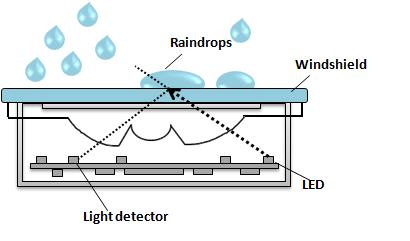Windshield Wiper Controls
- Basic Description
-

Windshield wipers keep the windshield of a vehicle clear from rain water, snow, dust and road spray. The first windshield wipers were operated manually by moving a lever inside the car. Later wiper designs were powered by the engine's manifold vacuum. Virtually all wipers today employ an electric motor coupled with a linkage mechanism and are actuated by a knob beside the steering wheel. The wiper blade speed can be adjusted by the driver.
Modern windshield wipers may also be run intermittently. The intermittent wiper option cycles the wipers on and off every few seconds rather than running constantly. Intermittent control first appeared in automobiles in the 1970's. The original intermittent wipers were controlled by a constant power source that was routed through a series of switches. Now, virtually all automotive wipers are controlled by a microprocessor.
Many wiper systems in cars today use a rain sensor to detect the speed at which the raindrops are falling on the windshield. A microprocessor evaluates the signals from the sensor to calculate the speed at which the wipers should move.
- Sensors
- Wiper switch, rain sensor
- Actuators
- Electric Motor
- Data Communications
- Rain sensing wiper controls generally use LIN data communication between sensors and control unit.
- Manufacturers
-
Bosch, Hydreon
- For More Information
- [1] Windshield Wiper Control, Karim Nice, How Stuff Works, Mar. 23, 2001.
- [2] Automatic Windshield Wipers,
Ohio History Central website.
- [3] Rain Sensor, Wikipedia.
- [4] LEXUS: ES2010-QuickGuide; Rain Sensing Windshield Wipers-HD, YouTube, Dec. 17, 2009.
- [5] 2013 Toyota Avalon Limited Driving with Automatic Rain Sensing Wipers at 40 mph at Night, YouTube, Jan. 11, 2013.
- [6] Rain-Sensing Windshield Wipers, YouTube, May 5, 2014.
|

